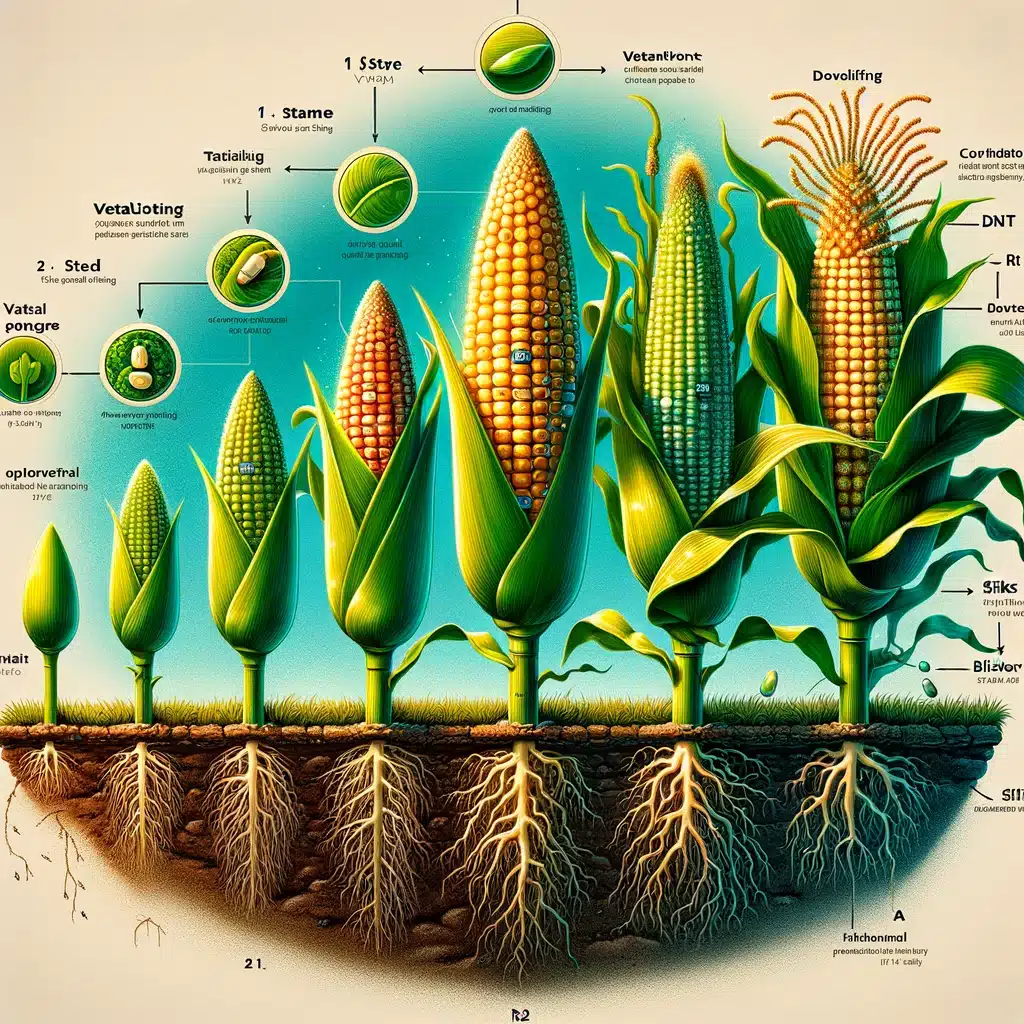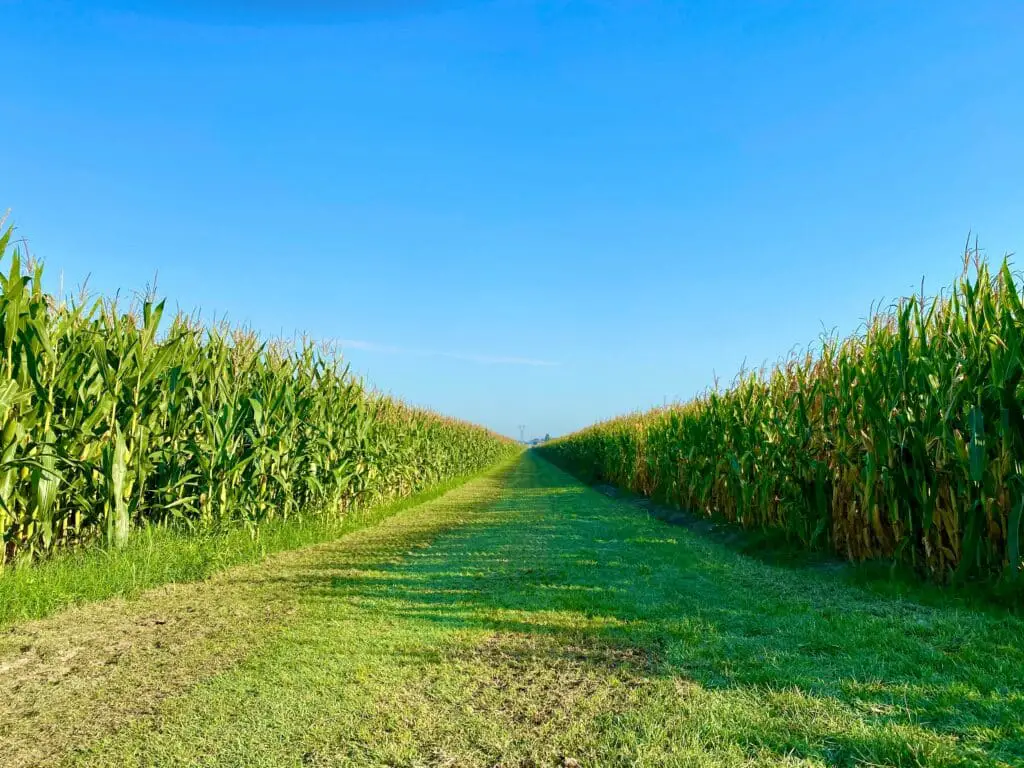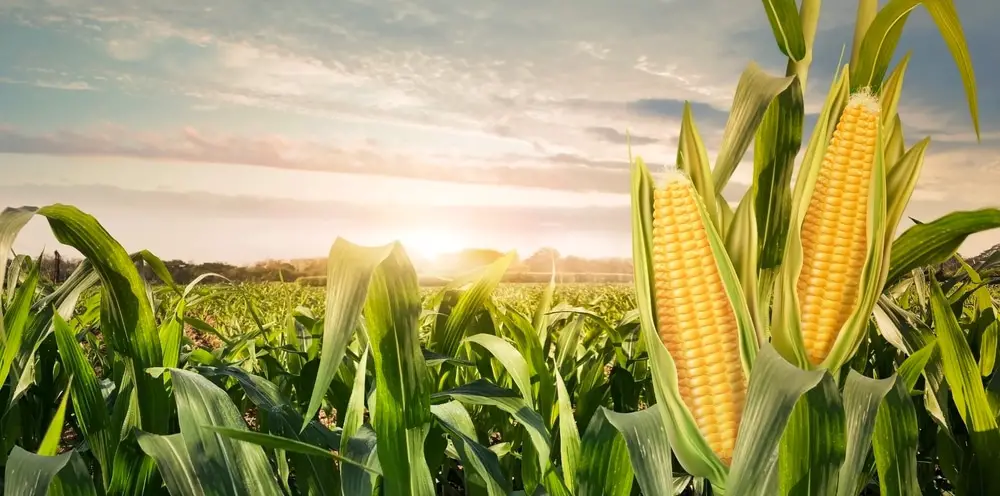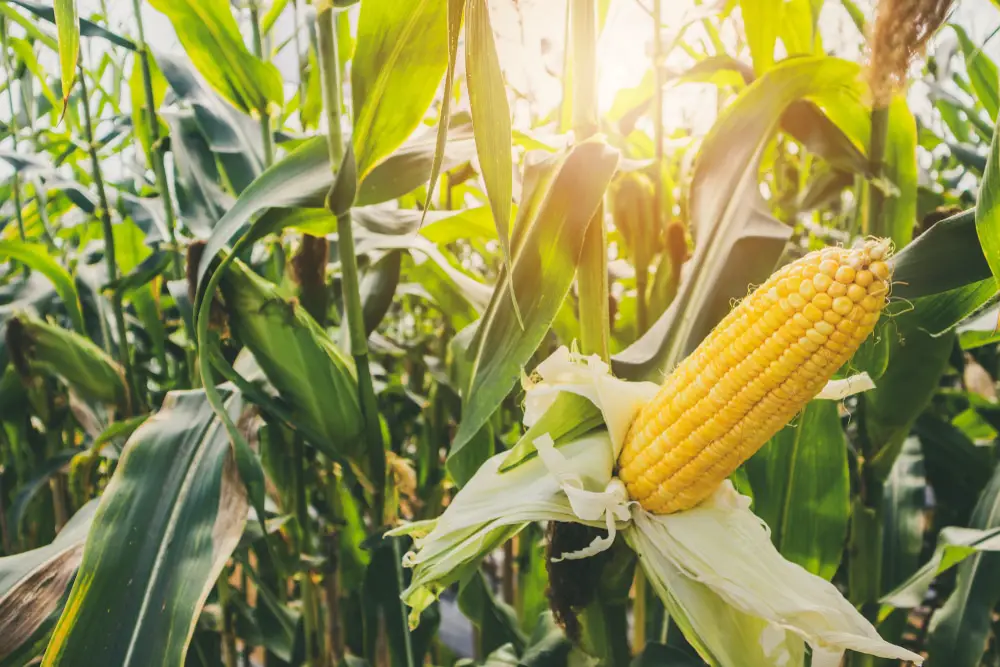The different growth stages of corn are crucial for how much it produces and its quality. Farmers use these stages to know when to fertilise, irrigate, cultivate, and control pests.
Understanding the growth stages of corn is fundamental. It enables precise timing of various field tasks, optimising resources and boosting yields. If you schedule tasks like fertilising, watering, and pest control, crops thrive and yield more.
This guide explains the different stages of corn cultivation and their importance for success. It also discusses the characteristics and implications of each stage.

The VE Stage: Emergence
The VE (Vegetative Emergence) stage marks the initial phase of corn growth. The seed sprouts and the young plant emerges from the soil.
During this stage, the coleoptile or protective sheath emerges, enclosing the first true leaves. These leaves initially remain rolled within the coleoptile and straighten as they reach for sunlight.
Early and successful emergence is vital for healthy plant population and crop yield.
Monitoring the initial growth allows farmers to assess the effectiveness of planting practices. It also allows making necessary adjustments for future planting cycles.
Vegetative Stages: V1, V2, V3, etc.
The vegetative stages encompass a series of growth phases distinguished by the development of leaves and roots. These stages lay the foundation for later reproductive growth.

Identifying and Counting Leaves with Collars
It’s crucial to properly identify and count leaves with collars. Doing so is the key to determine the vegetative stage of the plant. Collars can give us information about how a plant grows and develops.
- V1-V5 Stages: In the initial stages, the plant experiences significant growth.
At V1, a distinct leaf with a rounded tip emerges from the first collar. Nodal roots start elongating during this phase.
By V2, the plant reaches a height of 2 to 4 inches, relying on stored seed energy.
V3 marks the shift from kernel reserves to photosynthesis, as the nodal roots taking charge.
It’s essential to control broadleaf weeds around V4 to prevent losses.
By stage V5, you can easily tell the difference between leaf and ear shoots. They grow to a height of 8 to 12 inches, with the growing point under the soil surface.
- V6-V8 Stages: From V6 to V8, the plant undergoes a significant growth spurt.
Starting 4 to 6 weeks after emergence, the growing point emerges above the soil, making the plant susceptible to the elements.
Nodal roots become dominant, and rapid stem elongation begins around V7. By V8, the plant reaches a height of 24 inches.
- V9-V11 Stages: During V9 to V11, there is steady and rapid growth while also dry matter builds up.
At V9, the tassel begins rapid development, although it’s not yet visible. New leaves emerge every 2 to 3 days, and ear shoots start to develop.
- V12-Vnth Stages: Between V12 and later stages, the plant grows taller, reaching about 4 feet or more. There’s an increasing demand for nutrients and water during this period.
All leaves reach full size, with almost half exposed to sunlight. Brace roots start to develop, and the potential number of kernels per ear and ear size are still being determined.
Damage by Insects and hail during this period can reduce the number of developing kernels.
Around V15, the plant is around two weeks away from silking, with the tassel almost near full size but still not evident. If there’s lack of moisture and nutrients at this stage, it can limit potential kernels per row, resulting in shorter ears and reduced harvest.
Role of Nodal Root Development
The development of nodal roots is a critical aspect of vegetative growth to ensure the plant’s stability and nutrient uptake.
The presence of nodal roots becomes evident as the plant progresses through the vegetative stages. It helps secure the plant and ease optimal absorption of nutrients as it grows.
Importance of Tracking Vegetative Growth
Monitoring the growth stages up to V10 is crucial to implement appropriate management practices. Doing so at the right time ensures optimal crop development.
During the growing period, adjust fertilisation, irrigation, and other practices based on what you see.
VT Stage: Tasseling
The VT (Tasseling) stage signifies a crucial transition in the corn plant’s growth. It’s identified by the emergence of the tassel, which plays a vital role in pollination.
plant’s growth. It’s identified by the emergence of the tassel, which plays a vital role in pollination.
The tassels are the male reproductive structures responsible for releasing pollen. They are essential for fertilising the silks present on the ear and initiating the development of the kernels.
The wind carries the pollen shed by the tassels to reach the silks of the ear. Each silk corresponds to a potential kernel, and successful transfer of pollen is crucial for kernel development.
The success of pollination during tasseling impacts the potential yield of corn. Proper pollen transfer and fertilisation allow robust kernel development and a high-quality harvest.
R1 Stage: Silking
The R1 (Silking) stage is a vital reproductive phase where silks emerge. It initiates the pollination process, a crucial step in kernel development.
During this phase, the plant receives pollen and facilitate successful fertilisation. The silks serve as the conduit for pollen transfer to the ovules, ensuring the development of viable kernels.
During this phase, the silks are highly sensitive to environmental conditions. Stress factors such as drought or excessive heat can affect silk formation and pollination. It can lead to a decrease in kernel formation and affecting final yield.
To grow silk successfully, it’s important to have enough water in the soil and a good number of healthy plants.
R2 Stage: Blister
In the R2 (Blister) stage, small, white kernels with a transparent liquid content appear. The clear liquid within represents the early stages of endosperm development.
At this point, the focus is on monitoring the uniformity of kernel development across the ear. It’s important to check for any irregularities in size and growth. This may need adjusting nutrient application or irrigation.
It’s important to keep the soil moist and provide enough phosphorus and potassium during this stage. To form kernels early and build a strong foundation for later growth, these are necessary.
R3 Stage: Milk
In R3 (Milk) stage, the kernels begin to show signs of transition such as a milky texture, setting the stage for starch accumulation. It also plays a key role in determining the kernel size and quality.
The milky appearance of the kernels is due to the accumulation of sugars and proteins, which are crucial for starch formation.
Optimal management of water and nutrients is essential for promoting starch accumulation. To grow big and good kernels, it’s important to handle stress from pests and diseases.
R4 Stage: Dough
The R4 (Dough) stage is crucial in kernel development and characterised by the transition from milky to doughy kernels. The phase indicates the onset of starch accumulation.
As kernels change, they become less milky and doughier in texture and composition.
The transformation is vital for determining the final kernel composition and the quality of the harvested crop. Producing big kernels is important for livestock feed and different industries.

R5 Stage: Dent
The R5 (Dent) stage involves advanced kernel development, characterised by the appearance of a dent at the crown of the kernel.
The dent that appears is a result of the shrinking and drying of the kernel as it matures. This signifies the completion of kernel growth and the start of drying, essential for harvesting at the right time to ensure best quality.
The denting process is a key signal that the kernel has achieved maximum growth.
Harvesting at this stage ensures not only good quality kernels but also helps in planning the harvest efficiently. The aim is maximising yield and avoiding losses due to delayed harvest.
R6 Stage: Physiological Maturity
The R6 (Physiological Maturity) stage marks the point where the corn plant reaches its maximum dry matter accumulation. It’s also the time when kernel moisture content begins to decline.
At this stage, the kernels achieve their final size, weight, and moisture content, making it a critical milestone in the corn plant’s life cycle.
The drop in moisture content in the kernels is a crucial indicator that they’re ready for harvest.
Harvesting at the right time is critical to achieve the best possible quality. It’s a balance between allowing the kernels to achieve their greatest potential and avoiding the risk of excess dry-down.
Conclusion
Understanding the various growth stages of corn is fundamental for successful cultivation. Each stage presents unique characteristics that impact the overall yield and quality of the crop.
Farmers can use this knowledge to make better decisions about when to do important farming tasks to helps crops grow better and produce more.
Next time you see corn on the menu, you’ll have a new appreciation of how much care has been invested in its production!
Read More:
12 of the Best Companion Plants for Corn: A Comprehensive Guide

